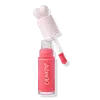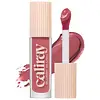Colourpop Liquid Blush Versus Caliray Blurry Blush
What's inside
What's inside
 Key Ingredients
Key Ingredients

 Benefits
Benefits

 Concerns
Concerns

 Ingredients Side-by-side
Ingredients Side-by-side

Hydrogenated Polyisobutene
EmollientIsododecane
EmollientSqualane
EmollientDisteardimonium Hectorite
StabilisingSilica
AbrasiveEthylene/Propylene/Styrene Copolymer
Octyldodecanol
EmollientNiacinamide
SmoothingPropylene Carbonate
SolventSodium Polyglutamate
HumectantRicinus Communis Seed Oil
MaskingSodium Hyaluronate
HumectantHelianthus Annuus Seed Wax
Skin ConditioningDiethylhexyl Syringylidenemalonate
Skin ProtectingPhenoxyethanol
PreservativeCaprylic/Capric Triglyceride
MaskingButylene/Ethylene/Styrene Copolymer
Caprylyl Glycol
EmollientEthylhexylglycerin
Skin ConditioningHexylene Glycol
EmulsifyingPentaerythrityl Tetra-Di-T-Butyl Hydroxyhydrocinnamate
AntioxidantChondrus Crispus
MaskingAlumina
AbrasiveTriethoxycaprylylsilane
Iron Oxides
CI 15850
Cosmetic ColorantCI 77891
Cosmetic ColorantCI 19140
Cosmetic ColorantHydrogenated Polyisobutene, Isododecane, Squalane, Disteardimonium Hectorite, Silica, Ethylene/Propylene/Styrene Copolymer, Octyldodecanol, Niacinamide, Propylene Carbonate, Sodium Polyglutamate, Ricinus Communis Seed Oil, Sodium Hyaluronate, Helianthus Annuus Seed Wax, Diethylhexyl Syringylidenemalonate, Phenoxyethanol, Caprylic/Capric Triglyceride, Butylene/Ethylene/Styrene Copolymer, Caprylyl Glycol, Ethylhexylglycerin, Hexylene Glycol, Pentaerythrityl Tetra-Di-T-Butyl Hydroxyhydrocinnamate, Chondrus Crispus, Alumina, Triethoxycaprylylsilane, Iron Oxides, CI 15850, CI 77891, CI 19140
Isododecane
EmollientTitanium Dioxide
Cosmetic ColorantCI 77891
Cosmetic ColorantSynthetic Fluorphlogopite
Mica
Cosmetic ColorantSilica
AbrasiveTrimethylsiloxysilicate
EmollientEthylene/Propylene/Styrene Copolymer
Disteardimonium Hectorite
StabilisingOctyldodecanol
EmollientIron Oxides
CI 77491
Cosmetic ColorantButylene/Ethylene/Styrene Copolymer
Silica Silylate
EmollientCaprylyl Glycol
Emollient1,2-Hexanediol
Skin ConditioningWater
Skin ConditioningTocopheryl Acetate
AntioxidantCI 15850
Cosmetic ColorantPentaerythrityl Tetra-Di-T-Butyl Hydroxyhydrocinnamate
AntioxidantNiacinamide
SmoothingKaolin
AbrasiveGlycerin
HumectantCopper Tripeptide-1
Skin ConditioningAlbizia Julibrissin Bark Extract
MaskingSodium Benzoate
MaskingDarutoside
Skin ConditioningIsododecane, Titanium Dioxide, CI 77891, Synthetic Fluorphlogopite, Mica, Silica, Trimethylsiloxysilicate, Ethylene/Propylene/Styrene Copolymer, Disteardimonium Hectorite, Octyldodecanol, Iron Oxides, CI 77491, Butylene/Ethylene/Styrene Copolymer, Silica Silylate, Caprylyl Glycol, 1,2-Hexanediol, Water, Tocopheryl Acetate, CI 15850, Pentaerythrityl Tetra-Di-T-Butyl Hydroxyhydrocinnamate, Niacinamide, Kaolin, Glycerin, Copper Tripeptide-1, Albizia Julibrissin Bark Extract, Sodium Benzoate, Darutoside
 Reviews
Reviews

Ingredients Explained
These ingredients are found in both products.
Ingredients higher up in an ingredient list are typically present in a larger amount.
We don't have a description for Butylene/Ethylene/Styrene Copolymer yet.
Caprylyl Glycol is a humectant and emollient, meaning it attracts and preserves moisture.
It is a common ingredient in many products, especially those designed to hydrate skin. The primary benefits are retaining moisture, skin softening, and promoting a healthy skin barrier.
Though Caprylyl Glycol is an alcohol derived from fatty acids, it is not the kind that can dry out skin.
This ingredient is also used as a preservative to extend the life of products. It has slight antimicrobial properties.
Learn more about Caprylyl GlycolCi 15850 is the pigment color red. It is an azo dye and created synthetically.
Azo dyes need to be thoroughly purified before use. This allows them to be more stable and longer-lasting.
This ingredient is common in foundations, lipsticks, and blushes. This color is described as brown/orangey red.
It has many secondary names such as Red 6 and Red 7. According to a manufacturer, Red 6 usually contains aluminum.
Learn more about CI 15850Ci 77891 is a white pigment from Titanium dioxide. It is naturally found in minerals such as rutile and ilmenite.
It's main function is to add a white color to cosmetics. It can also be mixed with other colors to create different shades.
Ci 77891 is commonly found in sunscreens due to its ability to block UV rays.
Learn more about CI 77891Disteardimonium Hectorite comes from the clay mineral named hectorite. It is used to add thickness to a product.
It can also help stabilize a product by helping to disperse other ingredients.
Hectorite is a rare, white clay mineral.
Learn more about Disteardimonium HectoriteWe don't have a description for Ethylene/Propylene/Styrene Copolymer yet.
Isododecane is a fragrance, emollient, and solvent.
As an emollient, it helps your skin stay soft and hydrated. Emollients help trap moisture into your skin.
Isododecane's role as a solvent makes it a great texture enhancer. It spreads smoothly on skin and does not leave a sticky feeling behind. Isododecane also helps prevent color transfer in makeup products.
Isododecane is not absorbed into skin.
Learn more about IsododecaneNiacinamide is a multitasking form of vitamin B3 that strengthens the skin barrier, reduces pores and dark spots, regulates oil, and improves signs of aging.
And the best part? It's gentle and well-tolerated by most skin types, including sensitive and reactive skin.
You might have heard of "niacin flush", or the reddening of skin that causes itchiness. Niacinamide has not been found to cause this.
In very rare cases, some individuals may not be able to tolerate niacinamide at all or experience an allergic reaction to it.
If you are experiencing flaking, irritation, and dryness with this ingredient, be sure to double check all your products as this ingredient can be found in all categories of skincare.
When incorporating niacinamide into your routine, look out for concentration amounts. Typically, 5% niacinamide provides benefits such as fading dark spots. However, if you have sensitive skin, it is better to begin with a smaller concentration.
When you apply niacinamide to your skin, your body converts it into nicotinamide adenine dinucleotide (NAD). NAD is an essential coenzyme that is already found in your cells as "fuel" and powers countless biological processes.
In your skin, NAD helps repair cell damage, produce new healthy cells, support collagen production, strengthen the skin barrier, and fight environmental stressors (like UV and pollution).
Our natural NAD levels start to decline with age, leading to slower skin repair, visible aging, and a weaker skin barrier. By providing your skin niacinamide, you're recharging your skin's NAD levels. This leads to stronger, healthier, and younger looking skin.
Another name for vitamin B3 is nicotinamide. This vitamin is water-soluble and our bodies don't store it. We obtain Vitamin B3 from either food or skincare. Meat, fish, wheat, yeast, and leafy greens contain vitamin B3.
The type of niacinamide used in skincare is synthetically created.
Learn more about NiacinamideOctyldodecanol is a fatty alcohol. It is primarily used to enhance the texture of products.
As an emulsifier, Octyldodecanol helps prevent the oils and waters from separating. It also prevents ingredients from creating foam when shaken.
Octyldodecanol is created by reducing fatty acid to an alcohol.
Due to its high molecular weight, it does not get absorbed into the skin.
Learn more about OctyldodecanolPentaerythrityl Tetra-Di-T-Butyl Hydroxyhydrocinnamate (long name, huh?) is a synthetic antioxidant.
It is used to help stabilize other antioxidants or prevent the color from changing in a product.
As an antioxidant, it helps fight free-radical molecules. Free-radical molecules are capable of damaging our cells and other genetic material. Thus, antioxidants may reduce the signs of aging.
This ingredient is oil-soluble.
Learn more about Pentaerythrityl Tetra-Di-T-Butyl HydroxyhydrocinnamateSilica, also known as silicon dioxide, is a naturally occurring mineral. It is used as a fine, spherical, and porous powder in cosmetics.
Though it has exfoliant properties, the function of silica varies depending on the product.
The unique structure of silica enhances the spreadability and adds smoothness, making it a great texture enhancer.
It is also used as an active carrier, emulsifier, and mattifier due to its ability to absorb excess oil.
In some products, tiny microneedles called spicules are made from silica or hydrolyzed sponge. When you rub them in, they lightly polish away dead skin layers and enhance the penetration of active ingredients.
Learn more about SilicaThis ingredient is a combination of red, black, and yellow iron oxide pigments. This combination of colors is usually found in foundation, because it results in a "skin" color.